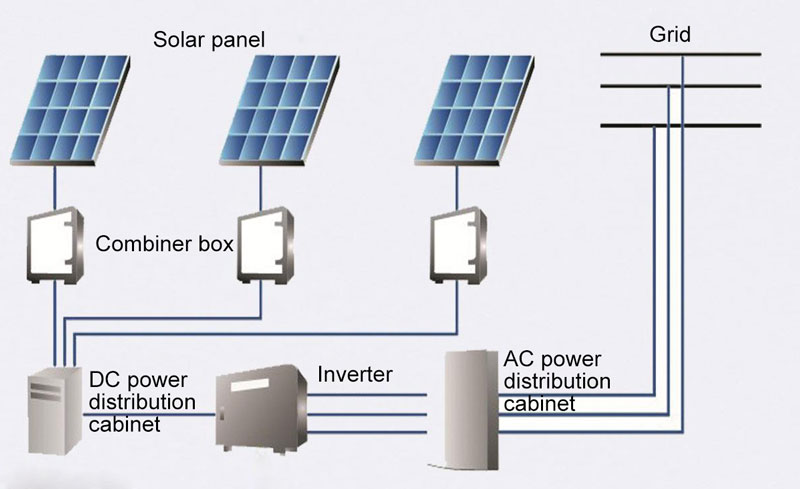The energy flow path of a grid-tie solar system usually contains a solar panels, a combiner box, a DC power distribution cabinet, an on-grid inverter, an AC power distribution cabinet, and the connection cables.
Based on the energy flow of the PV system, it is necessary to fully consider the six important factors affecting the conversion efficiency in the design of the solar power system.
 1. Climate conditions
1. Climate conditions
The solar panel modules are exposed in the natural environment for a long time, and factors such as wind and lightning will affect the solar cell. Light, wind, temperature and so on will change the photoelectric conversion efficiency of solar panels (cells), and some factors may even damage the functions and structures of the solar panels. It is required to fully collect the meteorological and environmental monitoring data in the solar power system design process.
2. Angle of inclination of solar panel
The solar panels need to absorb sunlight at the best angle, so that they can really play the role of improving the photoelectric conversion efficiency. Under different seasons, geographical locations and sunshine conditions, the optimal angleof inclination of solar panel will also have great changes, so the angleof inclination of the solar panels should be actively adjusted according to changes in seasons, latitude and longitude and sunshine hours. The fixed inclination angle should be chosen as the angle of inclination based on the maximum power generation in the whole year.
3. Cleanliness of solar panel surface
The cleanliness of solar panel surface also affects the photoelectric power conversion. It is required to know much about the actual situation of solar panel to be polluted in the environment, determine the contamination of the solar panel surface, especially the impact of strong wind, strong convection and sandstorm weather on the surface of solar panel, and then determine the cleaning frequency of the solar panels according to the local labor cost.
4. Solar panel spacing design (Shading)
Once the solar panel is sheltered, it will affect the power generation capacity of the solar system. Therefore, when designing the solar panel array spacing, it is necessary to consider the shading of the building to the solar panels and the self-shading between solar panels.
 5. MPPT tracking accuracy
5. MPPT tracking accuracy
As the sunshine and temperature change, the output voltage of the solar panels changes accordingly, and the output power of the PV array will change as well. The goal of maximum power point tracking (MPPT) for the solar inverter is to enable the PV array to achieve maximum power output in case of any sunlight and temperature change, so the accuracy of the MPPT greatly affects the system efficiency. Now, the solar charge controller is also widely used to track the maximum power point of solar power generation in real time. Our MPPT solar charge controllers including 20 Amp to 60 Amp have high charging efficiency over 98.5% and tracking accuracy over 99.73%.
6. Power loss of each part
The power loss of the RV system in energy conversion and transmission process includes:
- Solar panel matching loss
These losses are caused by the series connection of solar panels in different light conditions. - Loss of deviating from the maximum power point
The power loss is caused by temperature influence, maximum power point tracking (MPPT) accuracy and so on. - DC line loss
According to the relevant standards, the cable loss needs to be controlled within a certain range. - Conversion loss of solar inverter
Different operation power points affect efficiency in the DC/AC conversion process. - Loss of AC grid connection
The transmission efficiency from the inverter output to the high voltage grid is mainly considered to the transformer efficiency.
